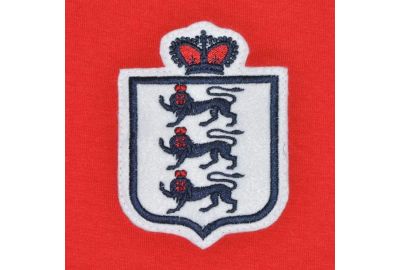"Three lions on a shirt... Jules Rimet still gleaming..."
You all know the song; you all know the badge. But why has English football become so synonymous with the three lions emblem? And why has this proud symbol become the enduring emblem of the England national team, featured on the oldest retro England football shirts, all the way through to the modern day?
As with so many aspects of British sporting culture, the answer to this question takes us far back into history. Let the retro shirt experts at TOFFS tell you the full story, and give you a bit more insight into the traditions that went into the creation of this iconic crest!
The historical origins of the three lions
Although the lions may be most recognisable to many people for their use in sporting contexts, the crest itself is based on the coat of arms of England, a royal symbol that was once carried into battle by England's armies, and has now come to symbolise the nation of England more generally.
The first English king to use a lion on his royal standard was King Henry I, who ruled from 1100 to 1135. A second lion was then added to the emblem after he married Adeliza of Louvain, whose father also bore a lion on his shield - although the version with two lions was used only rarely. Some years later, his grandson King Henry II, who reigned from 1154 to 1189, married Eleanor of Aquitaine, who also had a lion as part of her family crest, and a third lion was added to complete the iconic emblem we know today.
Their son, King Richard I - better known as Richard the Lionheart - was the succeeding monarch, and it was he who popularised the image of three golden lions on a scarlet background as a symbol of the English throne during his reign from 1189 to 1199. This solidified the connection between the three gold lions and the Plantagenet kings, and was subsequently adopted as the royal arms of England, used by every monarch since then.
Adoption by the Football Association
Fast forward to the late 19th century, when the newly formed Football Association (FA) sought an emblem to represent the organisation. The choice of the royal coat of arms was an obvious and logical one, serving both as a nod to the nation's royal history, and as a symbol of strength and courage on the field. When England played Scotland in their first official international match in 1872, the men of the first ever English football team did so with the three lions badge on their shirts, solidifying this as an integral part of the national sporting identity.
During the early years of the FA, the organisation used a specially designed variation of the three lions crest, replacing the golden lions and red background of the royal arms with a version that featured blue lions on a white background. When the FA was granted an official coat of arms by the College of Arms in 1949, the resulting crest maintained this same colour scheme, albeit with the addition of ten Tudor roses in the background, representing the various regional branches of the FA. Previously, the crest had featured a crown above the main emblem, but this was removed to help differentiate the badge from that of the English cricket team.
The badge was firmly immortalised in the world of international football when it was combined with the Jules Rimet trophy, a union flag and a globe-themed football to create the official logo of the iconic 1966 World Cup, hosted and won by England.
The three lions in modern football
Today, the three lions crest with its ten red roses has become synonymous with the England football team and its aspirations on the global stage. From the World Cup to the European Championships, the England badge has been worn with pride in countless tournaments, through historic victories and (more often than not!) heartbreaking defeats.
Of course, we couldn't finish this story without once again mentioning Three Lions, the chart-topping hit created by David Baddiel, Frank Skinner and The Lightning Seeds as the England team's official anthem for Euro 96. The song was an omnipresent fixture during that magical summer, being chanted loud and proud by fans all the way through England's memorable run to the semi-finals (and inevitable penalty shootout defeat by Germany). Since then, it's continued to endure as the England national team's most popular football song - and in doing so, further reinforcing the indelible link between the three lions and the hopes and dreams of this sporting nation.
If this trip through history has got you eager to wear the three lions with pride, take a look at TOFFS' incredible range of retro England football shirts! We've got replica kits and merchandise covering countless classic eras in England's rich football history - all with that legendary badge on the chest!











